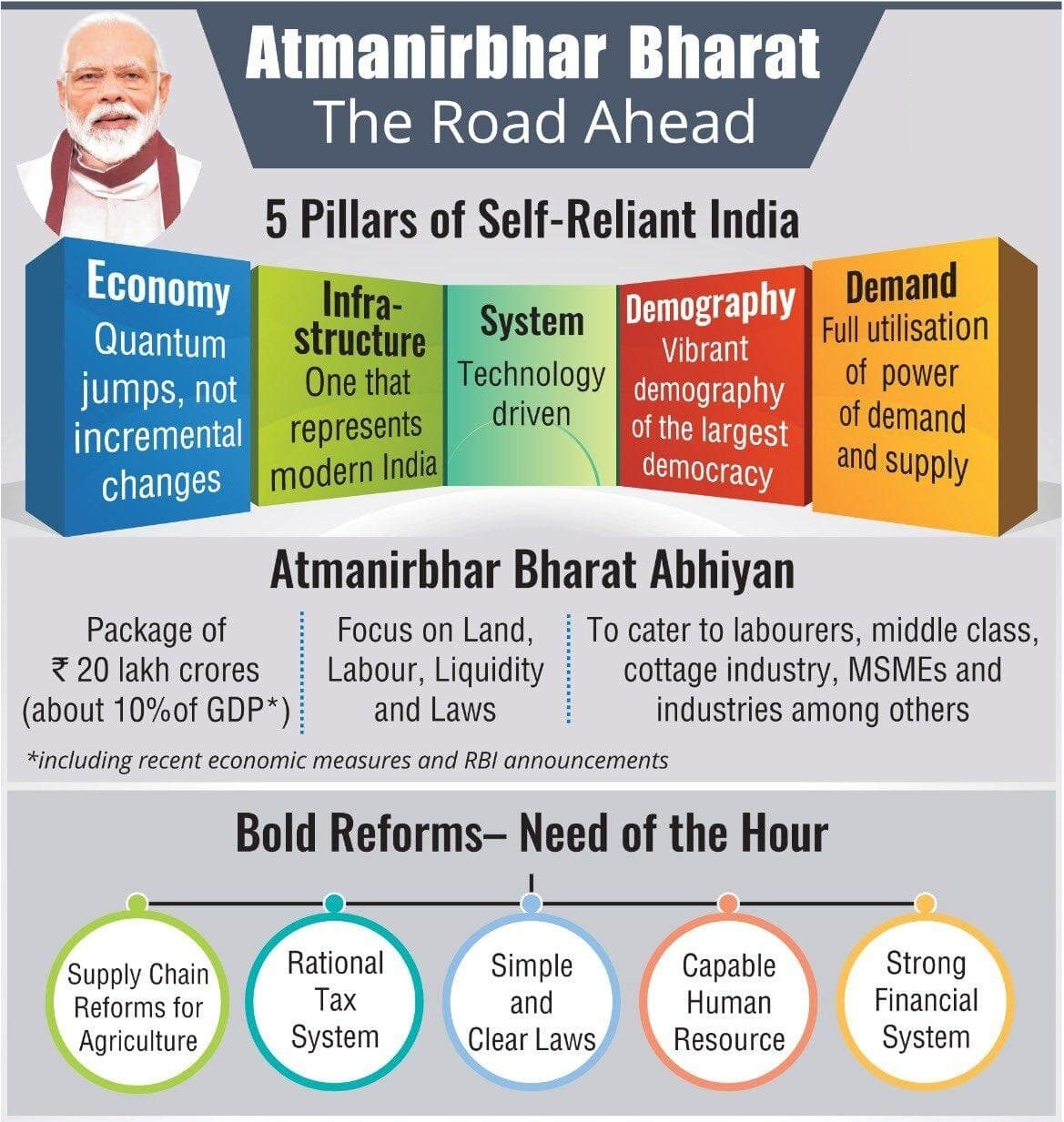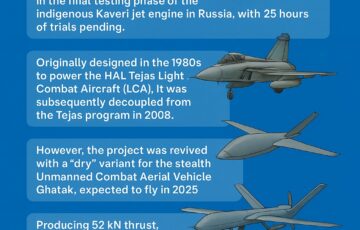Make in India (Aatmanirbharta) decade propels Hal’s growth
Syllabus:
GS-2: Government Policies & Interventions
GS – 3: Growth & Development
Focus:
The Make in India initiative has propelled Hindustan Aeronautics Limited (HAL) to new heights, enhancing India’s defence manufacturing capabilities. With significant policy reforms and increased foreign investments, HAL has shifted from reliance on foreign technologies to developing indigenous products, bolstering both economic growth and self-reliance in defence
Overview of Make in India Initiative:
- Launched by the Prime Minister, the initiative aims to position India as a global manufacturing hub.
- The defence sector, especially Hindustan Aeronautics Limited (HAL), has undergone significant changes in the past decade.
- HAL has evolved from producing high-tech assets to becoming a technology company with indigenous products.
- Key products include ALH Dhruv, Rudra, and LCA Tejas, reflecting HAL’s commitment to enhancing India’s defence capabilities.
- The initiative has helped HAL transition to integrated technology solutions and reduced reliance on foreign manufacturers.
What is Atmanirbhar Bharat?
- Refers to self-reliant India interacting globally on its own terms.
- Aims for self-sufficiency without being protectionist or isolationist.
- Launched in 2020 with a ₹20 lakh crore package (10% of GDP) to boost the economy.
Five Pillars of Atmanirbhar Bharat:
- Economy: Focus on a robust economic framework.
- Infrastructure: Development of sustainable and efficient infrastructure.
- System: Enhancing the overall governance and administrative systems.
- Vibrant Demography: Leveraging India’s diverse and youthful population.
- Demand: Stimulating demand through various initiatives.
Ideational Foundation Relevance:
- Inspired by Mahatma Gandhi’s Swadeshi movement, adapted for modern India.
- Emphasises harmonising regional aspirations with a national vision.
- Promotes a strong national identity rooted in liberal democratic values.
- Balances regional distinctiveness (e.g., Dravidian model) with nationalism.
Present Legal Framework for Defence Policies:
- Industries (Development and Regulation) Act, 1951:
- Regulates industrial development in the defence sector.
- Indian Army Act, 1950; Indian Air Force Act, 1950; Indian Navy Act, 1957:
- Governs the organisation, administration, and conduct of the armed forces
- FDI Policy and Regulations under FEMA, 1999:
- Outlines foreign direct investment norms in the defence sector.
- Defense Procurement Procedure, 2016:
- Establishes guidelines for acquiring defence equipment and services.
- Department of Industrial Policy and Promotion (DIPP):
- Facilitates policy formulation and implementation in defence industries.
About Hindustan Aeronautics Limited (HAL):
- Established: December 23, 1940, in Bangalore by Shri Walchand Hirachand.
- Headquarters: Bangalore, India.
- Key Role: Major aerospace and defence manufacturer with 11 R&D centres and 21 manufacturing divisions.
Evolution
- Early Years: Became a government shareholder in 1942, producing iconic aircraft like the Harlow Trainer and Curtiss Hawk Fighter.
- Innovations: Developed aircraft such as Pushpak, Krishak, HF-24 Jet Fighter (‘Marut’), and HJT-16 (‘Kiran’).
- Amalgamation: Merged Hindustan Aircraft Limited and Aeronautics India Limited in 1964 to form HAL.
Recent Developments
- Space Contributions: Supported ISRO’s launch vehicles since
- New Ventures: Established Light Combat Aircraft (LCA) Tejas Division in 2014 for indigenous innovation.
- Current Status: Recognized as a global leader in the aerospace and defence sector.
Government Policy Changes Supporting Indigenization:
- The government has introduced policies to promote indigenous design and development of defence equipment.
- Defense Acquisition Procedure (DAP) 2020 prioritises domestic procurement, reversing the import-export ratio to 70:30.
- In March 2022, the government announced 18 major defence platforms for industry-led design and development.
- A Positive Indigenization List was created to restrict imports of certain items, fostering local manufacturing.
- HAL’s shift from licensed manufacturing to indigenous design has resulted in advanced product development.
Boosting Self-Reliance and Indigenous Capability:
- The Make in India initiative has significantly increased India’s defence production capabilities.
- In FY 2023-24, defence production reached ₹1.27 lakh crore, marking a 7% growth from the previous year.
- HAL contributed7% to this growth, with its production value rising from ₹20,590 crore in FY 2019-20 to ₹30,118 crore in FY 2023-24.
- Enhanced indigenization has reduced dependency on foreign OEMs, improving serviceability and turnaround times for aircraft and helicopters.
- HAL’s increased efforts have led to significant foreign exchange savings and a growing vendor base.
Foreign Direct Investment (FDI) and Technology Transfer:
- The initiative has opened the defence sector to FDI, allowing up to 74% automatically and 100% with government approval in specific cases.
- Partnerships with global aerospace firms have facilitated advanced technology adoption in Indian manufacturing.
- HAL signed an MoU with General Electric in June 2023 for technology transfer and manufacturing of engines for the LCA MK2.
- A joint venture with Safran Helicopter Engines aims to develop engines for Indian multi-role helicopters, enhancing domestic capabilities.
- These initiatives are transforming the Indian aerospace engine manufacturing ecosystem.
Economic Benefits and Growth of SMEs:
- Make in India has spurred growth in small and medium enterprises (SMEs) within the aerospace and defence sector.
- HAL supports private industries, with over 2,000 registered subcontractors and technical assistance provided.
- HAL’s Srijan Portal invites private vendors for indigenous development of imported items.
- Collaboration with private vendors includes projects like Multi-Function Displays and Flight Data Recorders.
- HAL aims to become a leading aerospace integrator through strong partnerships with the private sector.
Job Creation and Skill Development:
- The initiative has generated numerous job opportunities across the aerospace and defence sectors.
- Increased demand for skilled labour in production, assembly, and R&D is evident.
- HAL has established an Aerospace and Aviation Sector Skill Council (AASSC) to develop specialised workforce skills.
- Skill development programs address the gap between demand and supply in various areas like manufacturing and operations.
- Support from stakeholders, including the Indian Defense Services and industry partners, has facilitated HAL’s success under the initiative.
Challenges in Achieving Atma Nirbharta in Defence Sector:
- Technological Gap:
- Developed nations have advanced technologies (e.g., stealth materials).
- India’s gross domestic expenditure on research (GERD) is stagnant at 0.7% of GDP, one of the lowest among BRICS.
- Bureaucracy and Efficiency Concerns:
- Slow defence procurement process causes delays, affecting budgets and timelines.
- Example: Submarine Project P-75I stuck at Request for Proposal stage since 2021.
- Industrial Ecosystem Woes:
- Requires a robust network of suppliers, manufacturers, and skilled workers.
- Only 110 out of 333 licensed private companies have started production.
- Geopolitical Considerations:
- Foreign suppliers are hesitant to transfer sensitive technologies.
- Example: British companies view India as challenging due to protectionist policies.
- Discouraging Regulatory Regime:
- Conflicting policies complicate compliance for domestic and foreign firms.
- Strict requirements for indigenous content hinder manufacturing.
- Limited Fiscal Space:
- High defence budget (INR 5.94 trillion) with 53% allocated to pensions, limiting modernization funds.
- Lacking Convergence:
- Discrepancy between manufacturers and defence forces’ requirements.
- Example: Navy rejected LCA Tejas for not meeting carrier-based aircraft criteria.
Way Forward: Towards Atma Nirbharta in Defence Sector:
- Focus on Research and Development:
- Support defence start-ups for innovation and niche capabilities.
- Joint Ventures and Technology Transfer:
- Form strategic partnerships with foreign companies to share technology and knowledge.
- Autonomy for Defence PSEs and PSUs:
- Grant greater operational and financial independence to state-owned enterprises.
- Reform in Defence Procurement Policies:
- Streamline processes to reduce bureaucracy and accelerate decision-making.
- Emphasis on Defence Export:
- Develop a robust export strategy, akin to the US’s Foreign Military Sales program.
- Shekatkar Committee:
- Suggest increasing retirement age to reallocate resources for R&D.
- Vijay Kelkar Committee:
- Involve leading private companies in defence production for enhanced capabilities.
Conclusion:
The transformation of HAL under the Make in India initiative illustrates the effectiveness of strategic policy reforms in advancing indigenous capabilities. By fostering self-reliance and enhancing technological expertise, India is not only strengthening its defence sector but also positioning itself as a competitive player in the global aerospace market.
Source: Hindustan Times
Mains Practice Question:
Discuss the impact of the Make in India initiative on India’s defence sector, specifically focusing on Hindustan Aeronautics Limited (HAL). What challenges and opportunities does this initiative present for the future of defence manufacturing in India?






